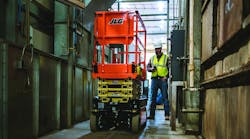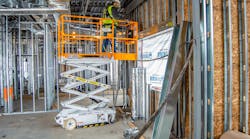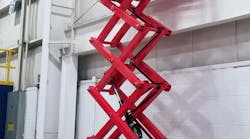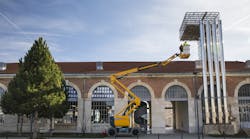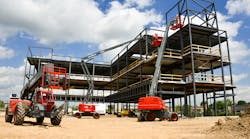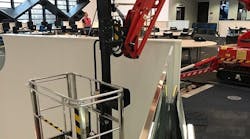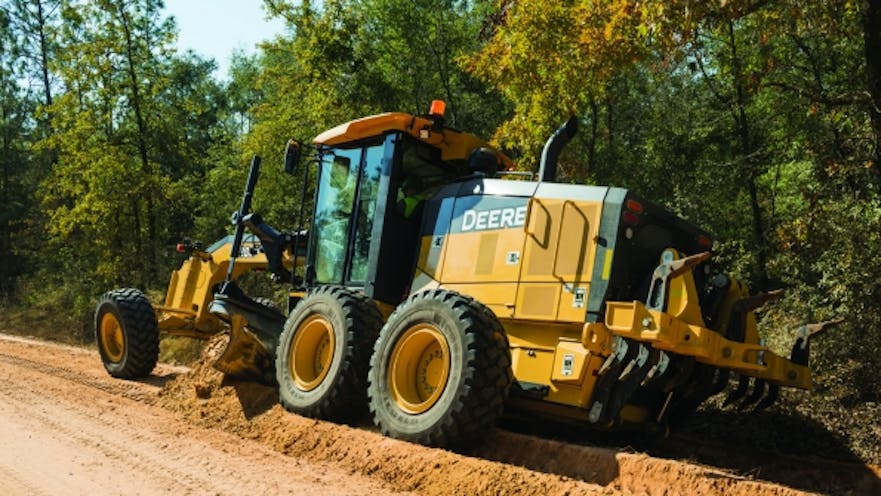RER interviews Mircea “Mig” Dobre, senior research analyst, diversified manufacturing & machinery at Robert W. Baird, about long-term growth in the housing industry, prospects for the 2019 economy, the importance of telematics and technology, watching oil prices, concerns over instability, consolidation, and why the millennial generation matters. And more.
By Michael Roth
RER: There was some volatility in the economy in 2018. What kind of impact did it have?
Dobre: You can deal with rough times whenever they occur, but what made the year so difficult was you couldn’t quite pinpoint exactly what was causing the roughness and there’s just so much volatility and uncertainty nowadays with our policy-makers that it’s been difficult to try to make a living in something as sensitive as the markets are when you have that level of uncertainty.
RER: I imagine some people panic when the market takes a downturn, right?
Dobre: There’s a little bit of that but if you’re also running a business and you have to make decisions and hire people and machines and capital and build things, that uncertainty doesn’t help. You want to know that we’re on a certain path and we’re going to do certain things and have some clarity around that. The whole back and forth that happening during the year, I think it rattled a lot of folks. So, let’s hope 2019 somehow ends up a little better than that.
RER: From your research, you seem very bullish long-term on the residential construction market.
Dobre: I don’t know if your readers are aware, but we really have been under-investing in residential construction. They know that housing is not where it’s been back in 2006, but I’m not sure that many of them are as aware as they should be about some of the demographic trends coming down the pike that support that business. I mean this is the kind of business where -- if I were in the rental industry -- I would really be putting my thinking cap on and wondering, “How do I capitalize for the next decade?” in regard to what I think is going to be a real trend for housing. I think because we’ve been so scarred from that ’08 downturn and the recovery has been so slow that in many ways it’s very easy to be cynical about housing and say, “It’s a little bit of growth but boy the bubble really hurt us.”
It’s true but that’s 12 years ago and things are changing not only in terms of the number of homes out there, but they’re changing at the population level. The kids are moving out, they’re getting married, they’re starting families. It could be because I’m an analyst, but I find the long-distance perspective very compelling.
RER: In terms of the quantity of millennials moving out from their families and starting households, is it that large a demographic group?
Dobre: It’s a huge opportunity. If you look at the chart on the change in households in 2018, there were more households formed in 2018 than at any point in time since the late 1970s. And look at what’s going on with the U.S. population by age, you see those two little mountains in there, one of them is the baby boomers, these folks turning 50 and 60 years old, and what’s going on right after is their kids, the millennials. And it’s these millennials that are forming households at a clip that we haven’t seen since 1977. They are finally getting married. And look what’s going on here with the U.S. home ownership rate. You look at that and you say “Yeah, sure, but probably a lot of them are going to rent places.” Which they do, and that’s why multi-family housing had a few great years, best since the 1980s. But look at the number of households, household formation, owner occupied. These are basically households that are forming and they’re buying homes. They are not renting.
Now you look at that and you compare it with renters. There’s something happening here, and this goes beyond China, trade wars and tax policies and whatever the Fed is doing with interest rates and all that, what’s happening here is demographically driven. I did not end up marrying my wife because the Fed cut interest rates by 25 basis points. Folks in the rental industry really need to internalize information like this as they plan for their businesses, not for the next 12 months but the next 10 years.
A lot of professional investors are not aware of some of these statistics. The folks out there busy doing real work, I would suspect that they’re not aware of this dynamic. They might know about it because they have kids who are getting married and are moving out, but to actually see the numbers, you go, “Holy smokes, it’s not just me, this is happening at a national level.”
RER: The mortgage rates have been pretty high.
Dobre: Yeah, and you’ll find something in there about mortgage rates as well, that’s been a bit of an issue. The realtors will tell you it’s a combination of things, it’s a combination of rising home prices and high mortgage rates that have resulted in more of a challenge for folks to pick up homes. But the funny thing, when we’re talking to people in the industry, we find out that there’s a little more subtlety to it. The demand is there, but the problem is the supply is not there for the kind of demand that exists.
Meaning a lot of these households are being formed in urban areas, not rural ones, and a lot of these households would like lower-priced properties. A couple of 24-year-olds getting married and maybe living in the New York City metropolitan area, they’re not going to be able to afford a $2 million apartment or a $3 million home. They need something that’s $500,000 that they can actually get a mortgage on. And that’s where the problem is. There’s not a lot of supply of these dollar-wise affordable homes for these folks to be able to move into. And I think that’s kind of what the industry needs to figure out at this point, how do you match that supply with demand? Which is a challenge, obviously.
RER: Overall, in a nutshell, what do you expect from the U.S. economy in 2019?
Dobre: If I were to sum it up in just a few words, I would say moderate growth. We’re still going to grow, but we’re going to grow at a slower clip than what we have seen in 2018 and I say that primarily because I do believe that financial conditions are tighter, we have higher interest rates, so we have a stronger dollar, that usually acts as a bit of a brake on growth. Some of the positive effects that we saw initially from tax reform are not going to go away. But we are lapping them in terms of comparisons, right? We have to deliver growth on top of that and the margins are going to be a little bit tougher.
But I think we’re going to continue to grow and I will tell you that one of the very big risks as far as growth is concerned -- and this is kind of stating the obvious -- is what happens with trade policy. Not only in the final outcome, which obviously if things escalate between the United States and China or between the United States and the European Union, that is very much going to be negative for growth. So, it’s not just the final outcome but it’s how we get there. If we continue to have uncertainty, and a back and forth and lack of resolution, that hesitancy can potentially result in the fall of investment. Because people will just sit on their hands and wait until there’s a conclusion they can plan around.
RER: How do you see oil and gas and petrochemical?
Dobre: The critical price for oil seems to be around $50. If oil prices are below $50, I think we see an erosion in investment, which will impact the rental industry. Obviously, folks in Texas, in Oklahoma, in North Dakota, Pennsylvania maybe, are the ones that would be most impacted. But really anything north of $50 in my mind should allow the industry to do well. There will be volatility, but you won’t have what you had in 2015.
RER: How about construction, residential and non-residential?
Dobre: The way I’m thinking about construction, bucketing it in two areas, residential and non-residential, residential is going to post very low growth. If I were to forecast it right now, I would say flat. I think we’re going to have a modest decline, early in 2019. We’ve already seen housing starts slow, but we’re going to start to see moderate growth in the back half of 2019, helped in part by lower interest rates.
On the non-residential side, I’m a little more optimistic. I see the private non-residential component growing 3 to 4 percent and the public side potentially growing as much as 5 percent. And when you look at what’s really been growing on the public side, we’re actually seeing real good funding disbursement on the state level, and even the federal government in the fiscal 2018 appropriations bill, and that provided incremental funding for construction and that’s coming through in a lot of transportation categories. If you look at airport construction, it has been tremendous. And that’s an area that’s going to continue to grow and we really need it. If you look at ports, if you look at rail, all these areas are seeing very good investment. Street and highway, not so much, this is a low-growth area, couple of percentage points probably at best. It’s really all these other transportation categories.
And on the private side we continue to see the institutional portion of the business grow nicely, this is health care, educational facilities, universities, schools, things of that nature, and also continued investment in warehousing. That has been, as you might be aware, a big area of growth, in great part because of e-commerce and the growth of Amazon and the like.
RER: But you’re saying if people understood the demographic changes, they should invest more in housing.
Dobre: It’s more of a longer-term outlook and view. I’ve said this in prior interviews, and I maintain the view, for everyone who operates a rental business their first concern is maintaining a healthy balance sheet and making sure that they don’t put themselves in a challenging position from a liquidity standpoint. So, you have to be mindful of the short term. But when you’re thinking about the long term, I think you absolutely have to keep an eye on housing. And some of your readers might be in the process of considering whether or not to acquire competitors, and it’s not just United Rentals that is doing it, others are as well. If I was out there trying to invest, I would be very keen on rental operators that have good exposure and good relationships with residential construction customers in good metropolitan areas.
Not just cities, but the larger suburbs are growing. I think that’s going to be a really good growth business over the next 10 years. If you think of places like Austin, Texas, for example, or Dallas, where you have a lot of growth in a broad metropolitan area. Even places on the East Coast, New York and such, that to me will remain a very attractive good return business through the cycle.
RER: Any concerns about issues or events that could derail growth?
Dobre: Well, we already spoke about trade wars. I’m not sure anybody ever wins them, and they are a real drag [on the economy], and there are two stages of them. There is Stage 2, which is the final conclusion, and in terms of risk you can have really bad outcomes. But there’s also Stage 1, which is where we’re in right now, which is we don’t know what’s happening. We know that things are uncertain and as a result, people might defer investment. So that is a risk for the industry and unfortunately there is no expert or forecast, and who knows because these things might change by tweet. That’s what makes life so difficult for folks in the financial industry to try to forecast these things.
RER: Are you optimistic about rental for 2019? What did you see in the survey of rental companies after the fourth quarter?
Dobre: Trends are still good in rental but there are some signs of weaker momentum (lots of equipment out there, utilization eroded a bit, pricing expected a little softer, some participants calling for weaker construction later in the year). The biggest deal from a forward outlook standpoint that we see, and survey respondents do not (yet!), is oil. Survey respondents react to actual changes in activity (rig count changes) and these are yet to come. Aerials and telehandlers are most at risk in my view, cranes are second.
So, if you have maybe slowing housing activity and then you get dealt this punch from oil and gas, that could potentially impact things, but we’ll see. It could prove to be temporary. The good news is that oil jumped back up above $50 and I think that will help with sentiment, but that’s to be determined.
Virtually all respondents expect continued construction market growth in 2019 (55 percent expect solid growth, 44 percent expect lower growth), at this point only about 20 percent expect oil and gas to decline (pipelines remain strong).
RER: We know there are labor shortages. Will that shortage stimulate new technologies?
Dobre: New technologies will be there regardless of labor shortages. And that’s a real opportunity to improve the efficiencies of customers for rental companies. And that is really the value proposition that a good rental operator would bring to the customer. Better asset utilization, more efficient employees, better profitability. And the way you do that is through technology. I believe that if we’re really separating the winners from the losers over the next 10 years in the industry, the winners are going to be companies that are able to employ the technology, first and foremost in understanding their own asset utilization and asset deployment. And there’s a lot of investment that’s happening in making sure that you have telematics, and good ability to track and utilize the data that’s generated from telematics.
So it’s asset utilization and then the assets that you own, those assets have to be technologically sound and have the ability to improve the end users’ performance and that’s where there’s an argument for an upgrade cycle, that’s where there’s differentiation between the shop that has productive new equipment and the shop that operates older machines that simply don’t have those advantages.
On labor shortages specifically, everyone is seeing it, and I mean it’s acute in manufacturing because in many cases that labor is skilled labor and you need trained machinists, you need welders. There’s a real competition for talent out there and there is no easy solution to it in the near term. You’re simply going to have to pay more for that talent. And people are.
RER: Do you expect consolidation to continue in the rental industry?
Dobre: The short answer is yes, I believe it will continue. Fluctuations in business, and I’m not talking about a downturn or a recession, just fluctuation, they only increase the drive for consolidation because you have operators, maybe smaller operators who all of a sudden realize the cost pressures they have in their business and if you end up with two or three bad months, even though it’s temporary, that might really get you to consider whether or not you should be selling your business and generate more efficiencies as part of a larger entity and group. And the big public guys, they remain very aggressive and I really don’t expect that to abate. The only thing that I think could bring this trend to a stop for a while would be either a recession or much higher cost of capital. And I’m really not seeing that coming.
